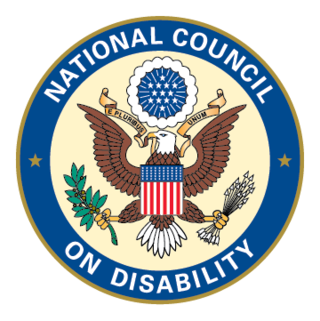Related Research Articles

The working poor are working people whose incomes fall below a given poverty line due to low-income jobs and low familial household income. These are people who spend at least 27 weeks in a year working or looking for employment, but remain under the poverty threshold.
The Workforce Investment Act of 1998 was a United States federal law that was repealed and replaced by the 2014 Workforce Innovation and Opportunity Act.
People with disabilities in the United States are a significant minority group, making up a fifth of the overall population and over half of Americans older than eighty. There is a complex history underlying the U.S. and its relationship with its disabled population, with great progress being made in the last century to improve the livelihood of disabled citizens through legislation providing protections and benefits. Most notably, the Americans with Disabilities Act is a comprehensive anti-discrimination policy that works to protect Americans with disabilities in public settings and the workplace.
Developmental disability is a diverse group of chronic conditions, comprising mental or physical impairments that arise before adulthood. Developmental disabilities cause individuals living with them many difficulties in certain areas of life, especially in "language, mobility, learning, self-help, and independent living". Developmental disabilities can be detected early on and persist throughout an individual's lifespan. Developmental disability that affects all areas of a child's development is sometimes referred to as global developmental delay.

The Rehabilitation Act of 1973 is a United States federal law, codified at 29 U.S.C. § 701 et seq. The principal sponsor of the bill was Rep. John Brademas (D-IN-3). The Rehabilitation Act of 1973 replaces preexisting laws to extend and revise the authorization of grants to States for vocational rehabilitation services, with special emphasis on services to those with the most severe disabilities, to expand special Federal responsibilities and research and training programs with respect to individuals with disabilities, to establish special responsibilities in the Secretary of Health, Education, and Welfare for coordination of all programs with respect to individuals with disabilities within the Department of Health, Education, and Welfare, and for other purposes. It created the Rehabilitation Services Administration.

Debra Ruh is an American business woman and advocate for the rights of persons with disabilities. She founded TecAccess, which provides software and services for information technology accessibility for people with disabilities and for Section 508 compliance.

The National Council on Disability (NCD) is an advisory agency on disability policy in the United States for all levels of government and for private sector entities.
Diversity, in a business context, is hiring and promoting employees from a variety of different backgrounds and identities. Those characteristics may include various legally protected groups, such as people of different religions or races, or backgrounds that are not legally protected, such as people from different social classes or educational levels. A business or group with people from a variety of backgrounds is called diverse; a business or group with people who are very similar to each other is not diverse.
The Rehabilitation Services Administration (RSA) is a federal agency under the United States Department of Education, Office of Special Education and Rehabilitative Services, and is headquartered within the Department of Education in Washington, D.C. It was established to administer portions of the Rehabilitation Act of 1973. Its mission is to provide leadership and resources to assist state and other agencies in providing vocational rehabilitation (VR) and other services to individuals with disabilities to maximize their employment, independence and integration into the community and the competitive labor market.
The United States Social Security Administration's Ticket to Work and Self-Sufficiency Program is the centerpiece of the Ticket to Work and Work Incentives Improvement Act of 1999.
Supported employment refers to service provisions wherein people with disabilities, including intellectual disabilities, mental health, and traumatic brain injury, among others, are assisted with obtaining and maintaining employment. Supported employment is considered to be one form of employment in which wages are expected, together with benefits from an employer in a competitive workplace, though some versions refer to disability agency paid employment. Companies such as Skilcraft in the United States are an example of "supported employment" which is defined in law for state and federal reimbursements.

The Fair Labor Standards Act of 1938 29 U.S.C. § 203 (FLSA) is a United States labor law that creates the right to a minimum wage, and "time-and-a-half" overtime pay when people work over forty hours a week. It also prohibits employment of minors in "oppressive child labor". It applies to employees engaged in interstate commerce or employed by an enterprise engaged in commerce or in the production of goods for commerce, unless the employer can claim an exemption from coverage. The Act was enacted by the 75th Congress and signed into law by President Franklin D. Roosevelt in 1938.
Customized employment (CE) is a way of personalizing the employment relationship between a candidate and an employer in order to meet the needs of both. It applies in particular to employees with disabilities. The individual employee's skills, interests and needs are identified in a process of "discovery", and job content and environment are tailored to these in a process of negotiation.
Assistive Technology Acts provide federal funding from the U.S. Department of Education to each state and territory to support "State efforts to improve the provision of assistive technology to individuals with disabilities of all ages through comprehensive statewide programs of technology-related assistance." Assistive Technologies are equipment, items or devices used to improve or keep the functionality of an individual with a disability. This will allow an individual with a disability to be more independent in life, this includes: education, recreation, and any daily activity. The services being offered for Assistive Technology include being able to use AT devices, assessment for the devices, and any maintenance included, such as customization, repair, and training. Under the Assistive Technology laws, federal grants are granted to each state to fund an Assistive Technology Act Project (ATAP) which provide services for individuals with disabilities, their families, guardians and more for their life span. The act, first passed in 1988, expires each years and needs to be continuously renewed to ensure the services can still be used.

Think Beyond The Label (TBTL) is a public-private partnership that delivers information, outreach and resources to businesses, job seekers and the public workforce system to ensure greater recruiting and hiring opportunities for job candidates with disabilities.
Council for Canadians with Disabilities (CCD), formerly known as the Coalition of Provincial Organizations of the Handicapped (COPOH), was created by people with disabilities in 1976 to provide support for all people with disabilities who seek the opportunity to go to school, work, volunteer, have a family, and participate in recreational, sport and cultural activities. The CCD is a national human rights organization of people with disabilities working for an accessible and inclusive Canada. In the 1970s, the CCD became a permanent part of the disability rights movement and it became a fluid entity that includes people with a range of different disabilities. To manage the work that will lead to the achievement of this goal, CCD established the following Committees to guide their activities in key areas:
- Human Rights Committee: Identifies Human Rights Committee issues of concern to persons with disabilities that could be addressed through law reform initiatives.
- Social Policy Committee: Identifies Social Policy Committee issues of national concern to persons with disabilities.
- Transportation Committee
- International Development Committee: Provides advice to CCD National Council on reforms that would improve the effect of Canada's foreign aid and policy on persons with disabilities.
- Access to Technology Committee.
The underprivileged are significantly more likely to have or incur a disability within their lifetime compared to more financially privileged populations. The rate of disability within impoverished nations is notably higher than that found in more developed countries. Since the early 2010s there has been growing research in support of an association between disability and poverty and of a cycle by which poverty and disability are mutually reinforcing. Physical, cognitive, mental, emotional, sensory, or developmental impairments independently or in tandem with one another may increase one's likelihood of becoming impoverished, while living in poverty may increase one's potential of having or acquiring disability in some capacity.

The Workforce Innovation and Opportunity Act (WIOA) is a United States public law that replaced the previous Workforce Investment Act of 1998 (WIA) as the primary federal workforce development legislation to bring about increased coordination among federal workforce development and related programs.
Dislocated worker funding is typically used to help workers in events of mass employment loss. A dislocated or displaced worker is defined as an individual who has been laid off or received notice of a potential layoff and has very little chance of finding employment in their current occupation when attempting to return to the workforce. Displaced workers are most frequently found in the manufacturing industry. Legislation addressing training for these workers was first introduced in 1959 through the passing of the Area Redevelopment Act of 1959. Over the years, legislation funding these programs has included wording holding states and private businesses accountable for the roles in the dislocation of workers. Due to the importance of this funding and the negative economic impact of displaced workers, the United States has passed continuing legislation as recent as 2014 and 2015.
Sylvia Walker was a disability rights activist and professor with the School of Education at Howard University.
References
- ↑ "What is National Disability Employment Awareness Month?". Department of Labor. Retrieved 4 January 2010.
- ↑ "About | National Disability Employment Awareness Month | Library of Congress". The Library of Congress. Retrieved 2018-11-01.
- ↑ "National Disability Employment Awareness Month: October 2018". www.census.gov. United States Census Bureau. Retrieved 2018-10-30.
- 1 2 3 4 5 "National Disability Employment Awareness Month Timeline" (PDF). 2016. Retrieved 2018-10-16.
- ↑ "Executive Order 13163". US Department of Transportation. 2015-04-07. Retrieved 2018-10-30.
- 1 2 "Disability Employment Initiative (DEI) - Office of Disability Employment Policy - United States Department of Labor". www.dol.gov. Retrieved 2018-10-30.
- ↑ "WorkforceGPS: Disability Employment Initiative". dei.workforcegps.org. Retrieved 2018-10-30.
- ↑ "Coordinations with Partner Programs" (PDF). United States Department of Labor. Retrieved 2018-10-29.
- ↑ "National Disability Employment Awareness Month Facts and Figures" (PDF). DiversityInc. 2016. Retrieved 2018-10-16.